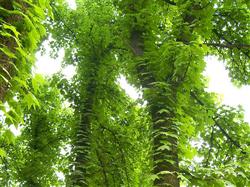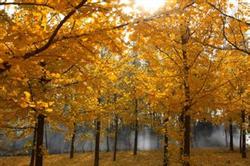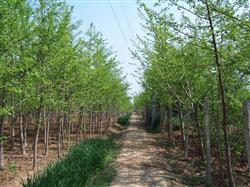High-yield cultivation techniques of Ginkgo biloba for leaves

1. Site selection of leaf ginkgo orchard requires flat terrain, good drainage and irrigation conditions, fertile loam or sandy loam, and it is not suitable to build leaf ginkgo orchard in saline-alkali land and mountain thin land. two。 Planting technology Ginkgo biloba orchard can be directly sowed or planted with seedlings or cuttings. The planting time can be either in spring or autumn, and the seedlings or cutting seedlings should be 1 ~ 2 years old, requiring strong rhizome, height above 25 cm, complete root system, luxuriant branches and leaves, no diseases and insect pests and so on. The planting density should be adjusted to local conditions, and the areas with fertile soil, less branches and leaves of varieties and high level of management can be slightly denser, otherwise they should be sparse, and the general row spacing is 0.4 m × 1.0 m. The planting density of large and small rows can be 1.0 m × 0.3 m and 0.5 m × 0.3 m. In addition, in order to make full use of the land, dwarf crops can be intercropped within 1-2 years after planting sparse gardens. 3. Soil fertilizer and water management to obtain high-yield and high-quality ginkgo biloba leaves, it is necessary to strengthen soil management and have adequate fertilizer and water supply. Soil management is mainly weeding and preserving soil moisture, and weeding is carried out every half a month in combination with weeding in the growing season to reduce surface evaporation and maintain soil moisture. From leaf harvesting to freezing in autumn every year, organic fertilizer can be deeply applied combined with soil ploughing; in the early growth stage of Ginkgo biloba (from April to May), topdressing should be increased, nitrogen fertilizer should be given priority to, and phosphorus and potassium fertilizer should be properly mixed; in the middle and later period (late July). At the same time, foliar fertilizer should be sprayed for 3 or 4 times during the growing period (urea, potassium dihydrogen phosphate, etc.), which can significantly increase leaf yield and improve leaf quality. Because of the large number of leaves and large transpiration, the leaf ginkgo orchard must have sufficient water supply, especially in the high temperature season from July to August. Generally, the soil is irrigated 6-8 times a year, that is, "sprout water" is irrigated once after soil thawing in early spring, and "frozen water" is watered once a month in April-June and August-October according to soil moisture in the growing season. Keep the soil water content about 80%, but ginkgo biloba is afraid of waterlogging, so we should pay attention to timely drainage when waterlogging. 4. Ginkgo orchard for shaping and pruning leaves is mainly leaf harvesting. In order to facilitate leaf picking and tree management, leaf picking trees should adopt cup shape or round head shape with short stem and low crown, and the trunk height should be controlled below 50 cm. Under the fixed trunk cut, three branches sprouting in different directions are selected as the main branches, and multi-stage lateral branches are cultured on the main branches. The shape of the leaf-picking tree can also be used as a cluster shape. When the 1-and 2-year-old seedlings are planted or the seeds germinate and begin to grow, they all need to be cut off at 20 cm from the ground to promote new branches; when the new branches grow to 10-15 cm, five main branches are selected according to different directions, and the rest are cut off; when the five branches grow to 30 cm each, they are coring again and sprout lateral branches, which is cultivated for 3 to 5 times to form a tufted crown. In order to promote leaf harvesting trees to have more branches and control the tree height within the operating height, heavy pruning should be carried out in winter, timely replacement and renewal of branches, and at the same time, some overdense branches, disease and insect branches and thin and weak branches should be removed at the same time; pruning in the growing season, mainly in late May, is mainly to coring new shoots of more than 30 cm, effectively promoting secondary shoots and increasing the number of branches and leaves; in autumn, combined with leaf picking, attention should be paid to dredging overdense and prosperous branches. 5. The control of diseases and insect pests of Ginkgo biloba is less, and it is mainly vulnerable to stem rot, leaf blight, large silkworm moth, ultra-small leaf moth and so on. On the basis of selecting improved varieties, strengthening management and timely treatment of diseased plants, timely spraying and control should be carried out. The medicament can choose 1% 2% ferrous sulfate solution, 50% carbendazim 600 × 700 times solution, 70% methyl topiramate 800 × 1000 times solution, and so on. 6. Ginkgo biloba leaves should be harvested by stages, generally starting from the first ten days of August, the basal leaves should be picked first, and then the middle and upper leaves should be harvested one after another. Pick 3 leaves of each twig, and finish it for the last time when the leaves of ginkgo biloba are about to turn yellow. If ginkgo biloba leaves are collected at one time, it will not only affect the quality of ginkgo biloba leaves, but also make the tree form secondary growth and affect its safety to survive the winter. In order to prevent the sprouting of winter buds, 3-5 leaves at the top must be retained before the local early frost period, and not all of them should be harvested; in addition, irrigation should be avoided in the nursery before picking leaves to ensure the quality of leaves and the safety of fresh leaves in the process of transportation. Ginkgo biloba leaves should be dried on the field or on the cement floor immediately after collection to prevent heat and mildew, while removing weeds, branches, soil and moldy leaves and other sundries, the drying thickness is 3-5 cm, turn 2-3 times a day, 3-4 days after reaching the air-dried state can be preserved or sold. Finally, special attention is paid to the fact that ginkgo biloba can not be harvested in summer and autumn. Double harvesting not only can not improve the yield and quality of leaves, but also harms the tree, resulting in greater economic losses.
- Prev

Management of cultivation techniques of Ginkgo biloba in different time
Ginkgo biloba is an ancient tree species in China and the oldest relict plant among the existing seed plants. Its leaves are of great medicinal value, and so far more than 160 kinds of ginkgo biloba extracts have been known. Mainly flavonoids, terpenoids, phenols, alkaloids, polyisopentene, quinic acid and so on. With the research in the past 20 years.
- Next

Conservation measures of Ginkgo biloba trees in summer
1. The life of Ginkgo biloba is very long, but improper planting management, especially the loss of topsoil, will make a large number of roots exposed on the surface. Ginkgo biloba growing on the slope is particularly prominent, when serious, the depth of root exposure can reach more than 30 cm. Therefore, we should do a good job of soil cultivation, so that the root system is buried below the soil surface, in order to fully develop.
Related
- Fuxing push coffee new agricultural production and marketing class: lack of small-scale processing plants
- Jujube rice field leisure farm deep ploughing Yilan for five years to create a space for organic food and play
- Nongyu Farm-A trial of organic papaya for brave women with advanced technology
- Four points for attention in the prevention and control of diseases and insect pests of edible fungi
- How to add nutrient solution to Edible Fungi
- Is there any good way to control edible fungus mites?
- Open Inoculation Technology of Edible Fungi
- Is there any clever way to use fertilizer for edible fungus in winter?
- What agents are used to kill the pathogens of edible fungi in the mushroom shed?
- Rapid drying of Edible Fungi

